ASUS Maximus VII Impact Review: Premium Gaming Z97 in mini-ITX
by Ian Cutress on December 9, 2014 10:00 AM ESTMany thanks to...
We must thank the following companies for kindly providing hardware for our test bed:
Thank you to OCZ for providing us with PSUs and SSDs.
Thank you to G.Skill for providing us with memory.
Thank you to Corsair for providing us with an AX1200i PSU and a Corsair H80i CLC.
Thank you to MSI for providing us with the NVIDIA GTX 770 Lightning GPUs.
Thank you to Rosewill for providing us with PSUs and RK-9100 keyboards.
Thank you to ASRock for providing us with some IO testing kit.
Thank you to Cooler Master for providing us with Nepton 140XL CLCs.
Test Setup
| Test Setup | |
| Processor | Intel Core i7-4770K ES 4 Cores, 8 Threads, 3.5 GHz (3.9 GHz Turbo) |
| Motherboard | ASUS Maximus VII Impact |
| Cooling | Cooler Master Nepton 140XL Corsair H80i Thermaltake TRUE Copper |
| Power Supply | OCZ 1250W Gold ZX Series Corsair AX1200i Platinum PSU |
| Memory | G.Skill RipjawsZ 4x4 GB DDR3-1600 9-11-9 Kit |
| Memory Settings | 1600 9-11-9-27 1T tRFC 240 |
| Video Cards | MSI GTX 770 Lightning 2GB (1150/1202 Boost) |
| Video Drivers | NVIDIA Drivers 337 |
| Hard Drive | OCZ Vertex 3 256GB |
| Optical Drive | LG GH22NS50 |
| Case | Open Test Bed |
| Operating System | Windows 7 64-bit SP1 |
| USB 2/3 Testing | OCZ Vertex 3 240GB with SATA->USB Adaptor |
System Benchmarks
Power Consumption
Power consumption was tested on the system while in a single MSI GTX 770 Lightning GPU configuration with a wall meter connected to the OCZ 1250W power supply. This power supply is Gold rated, and as I am in the UK on a 230-240 V supply, leads to ~75% efficiency > 50W, and 90%+ efficiency at 250W, suitable for both idle and multi-GPU loading. This method of power reading allows us to compare the power management of the UEFI and the board to supply components with power under load, and includes typical PSU losses due to efficiency. These are the real world values that consumers may expect from a typical system (minus the monitor) using this motherboard.
While this method for power measurement may not be ideal, and you feel these numbers are not representative due to the high wattage power supply being used (we use the same PSU to remain consistent over a series of reviews, and the fact that some boards on our test bed get tested with three or four high powered GPUs), the important point to take away is the relationship between the numbers. These boards are all under the same conditions, and thus the differences between them should be easy to spot.
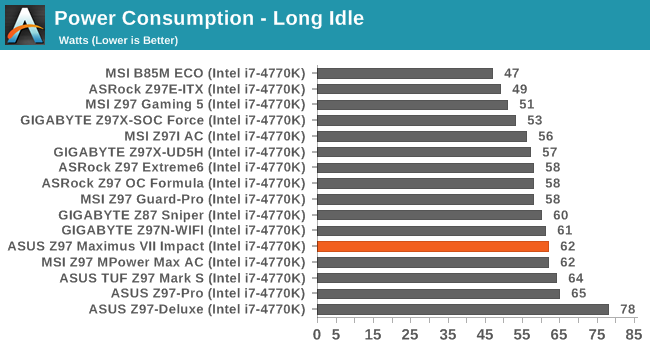
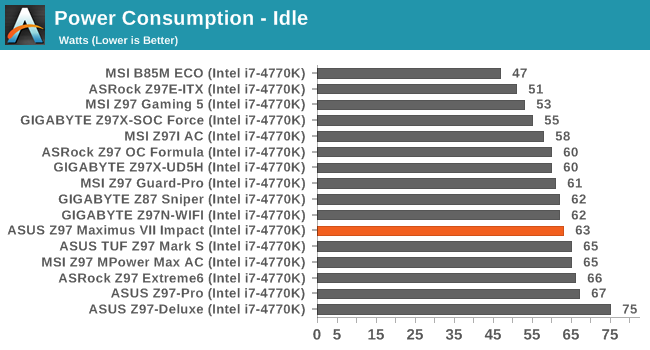
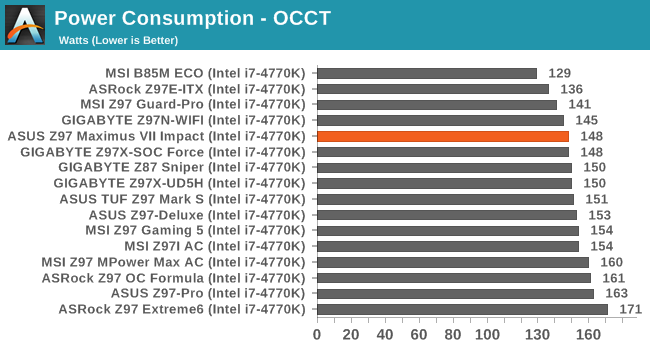
Peak power consumption was just under the 150W mark, resulting in a low idle-to-peak variation of 86W. Idle numbers were actually quite high, though it is hard to pin down if this is down to general design choices or the daughterboard design resulting in small but extra losses.
Windows 7 POST Time
Different motherboards have different POST sequences before an operating system is initialized. A lot of this is dependent on the board itself, and POST boot time is determined by the controllers on board (and the sequence of how those extras are organized). As part of our testing, we look at the POST Boot Time using a stopwatch. This is the time from pressing the ON button on the computer to when Windows 7 starts loading. (We discount Windows loading as it is highly variable given Windows specific features.)
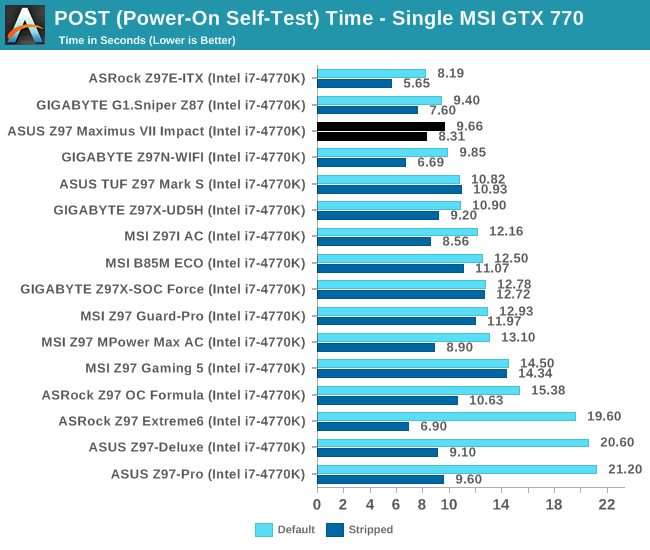
Less than 10 seconds POST time is a good benchmark in which the Impact did well.
Rightmark Audio Analyzer 6.2.5
Rightmark:AA indicates how well the sound system is built and isolated from electrical interference (either internally or externally). For this test we connect the Line Out to the Line In using a short six inch 3.5mm to 3.5mm high-quality jack, turn the OS speaker volume to 100%, and run the Rightmark default test suite at 192 kHz, 24-bit. The OS is tuned to 192 kHz/24-bit input and output, and the Line-In volume is adjusted until we have the best RMAA value in the mini-pretest. We look specifically at the Dynamic Range of the audio codec used on board, as well as the Total Harmonic Distortion + Noise.
Unfortunately our audio results were a little off due to a defect in our sound system. As shown in the image above, we had an odd situation where less than 300 Hz the THD+N response was some 30 dB different to what we would expect. ASUS sent us some results from a board in their offices that showed normal response, indicating that perhaps mine had a slight issue.
USB Backup
For this benchmark, we transfer a set size of files from the SSD to the USB drive using DiskBench, which monitors the time taken to transfer. The files transferred are a 1.52 GB set of 2867 files across 320 folders – 95% of these files are small typical website files, and the rest (90% of the size) are small 30 second HD videos. In an update to pre-Z87 testing, we also run MaxCPU to load up one of the threads during the test which improves general performance up to 15% by causing all the internal pathways to run at full speed.

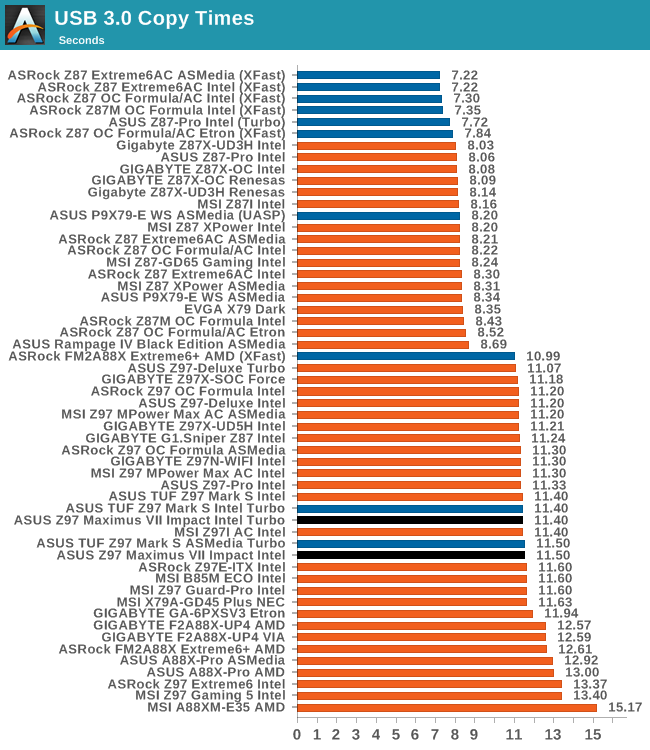
USB 2.0 performance on the Impact was slightly better than our previous Z97 results, with USB 3.0 coming in ballpark.
DPC Latency
Deferred Procedure Call latency is a way in which Windows handles interrupt servicing. In order to wait for a processor to acknowledge the request, the system will queue all interrupt requests by priority. Critical interrupts will be handled as soon as possible, whereas lesser priority requests such as audio will be further down the line. If the audio device requires data, it will have to wait until the request is processed before the buffer is filled.
If the device drivers of higher priority components in a system are poorly implemented, this can cause delays in request scheduling and process time. This can lead to an empty audio buffer and characteristic audible pauses, pops and clicks. The DPC latency checker measures how much time is taken processing DPCs from driver invocation. The lower the value will result in better audio transfer at smaller buffer sizes. Results are measured in microseconds.
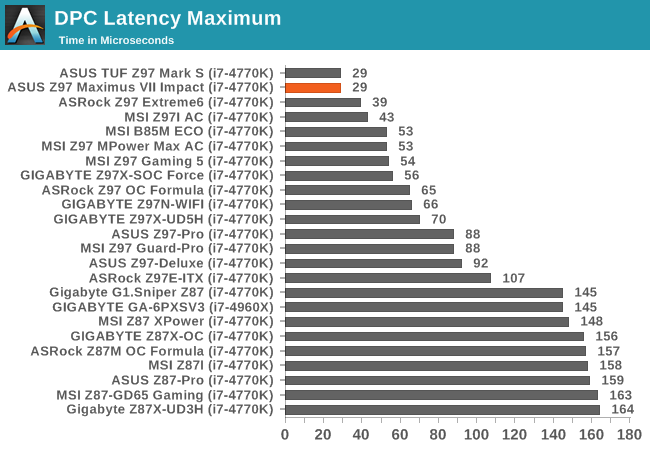
One of the super positive results to come from this review is the DPC Latency. The Impact came in at 29 microseconds, the same as the ASUS TUF Z97 Mark S, matching the best ever result.


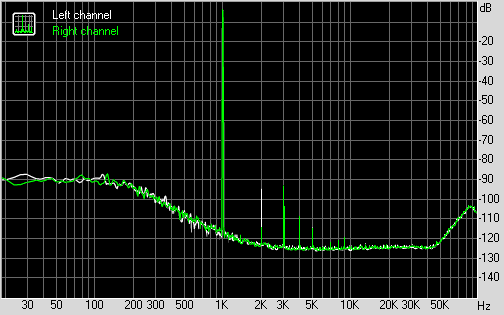








41 Comments
View All Comments
mooninite - Thursday, December 11, 2014 - link
The stock Intel cooler was what I originally had with my Impact and 4790k. Running an ffmpeg, h264 encode would reach 100C (the thermal limit) and throttle within a few minutes. I then purchased a ZALMAN CNPS8900 Extreme. This allowed ffmpeg to run while staying just under the 100C limit. After further reading of the Intel forum, with Intel support representatives replying, the motherboards are syncing all ratios, and a proper 44/44/43/42 ratio setting dropped temps even further to below 80C.Undervolting is next to impossible on stock clocks. I have my adaptive voltage set to -0.05v. Anything more and the system is not stable.
WithoutWeakness - Wednesday, December 10, 2014 - link
I think ASUS assumes that if you're spending $200+ on one of their ROG-branded motherboards and $200-$300+ on a K-series unlocked processor then you're also probably spending $50+ on a CPU cooler that is good enough to cope with the additional heat of a few hundred MHz overclock and the potential corresponding voltage bump that comes with it.It might be an unfair assumption to expect all users to buy a separate CPU cooler but they're targeting a certain audience with their ROG hardware and know that most of those users won't just rely on the stock heatsink/fan to keep their CPU adequately cooled.
takeshi7 - Tuesday, December 9, 2014 - link
I don't understand why manufacturers don't include 5.1 analog audio on high end ITX boards. If I can't have a sound card I'd at least like to have nice integrated audio.xenol - Tuesday, December 9, 2014 - link
Many of them do have the full set of 5.1 with mic and line-in. I'm sure this board just multiplexes the ports.nathanddrews - Tuesday, December 9, 2014 - link
My guess is that if you care that much about high quality audio, you would want to pass through to an external receiver/DAC/amplifier. From my experience onboard DAC always results in audible feedback. Digital out to an AVR resolves it.bigboxes - Tuesday, December 9, 2014 - link
He said nice, not high end. I have great sounding audio. Granted it's not on-board. Rather it's a Soundblaster X-Fi card paired with some Swans. If you are that anal about audio then you are going to do as you prescribed. However, we all don't want receiver/DAC/amps on our desktops. Don't blame you if you do though just don't poo-pah the OP for making the suggestion.bigboxes - Tuesday, December 9, 2014 - link
With such a small board there is no place for a external DAC add in card, hence your comment. I wasn't thinking about that.Pork@III - Tuesday, December 9, 2014 - link
The parameters and component of test system are unreal experiment with board which mainly to relevant for HTPC.ExarKun333 - Tuesday, December 9, 2014 - link
I like the error LED on the back plate. Very handy for a cramped build.Laststop311 - Tuesday, December 9, 2014 - link
This is without a doubt the very best mini itx board on the market period. If I was going to build a mini itx system this is the board I would get. And for being the very best available the price isn't all that bad.